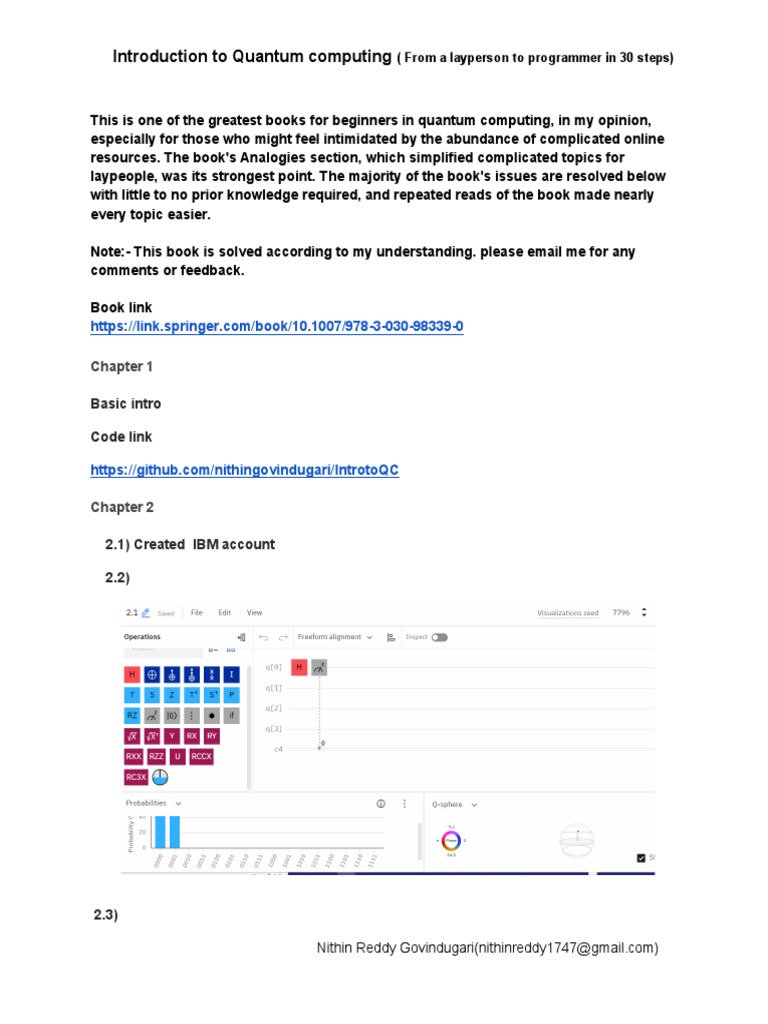Quantum computing represents a paradigm shift in the landscape of computational power, leveraging the principles of quantum mechanics to perform operations that classical computers cannot achieve efficiently. As the field garners increasing attention, a multitude of individuals—ranging from industry professionals to enthusiastic hobbyists—are eager to delve into this captivating domain. The allure is not merely technological; it resonates with the tantalizing prospect of solving problems previously deemed insurmountable. This article outlines a comprehensive approach for those embarking on an expedition into quantum computing.
1. Understand the Fundamentals of Quantum Mechanics
To equip oneself for the intricacies of quantum computing, one must first navigate the foundational principles of quantum mechanics. Key concepts such as superposition, entanglement, and quantum interference define the behavior of quantum systems. Superposition allows quantum bits, or qubits, to exist in multiple states simultaneously, thereby exponentially increasing potential computational power. Entanglement, a mysterious correlation between qubits regardless of distance, enables profound computational efficiencies. Successfully grasping these principles is vital; they are the bedrock upon which quantum algorithms are built.
2. Acquire a Robust Background in Classical Computing
Before diving deep into quantum phenomena, it is imperative to possess a robust understanding of classical computing paradigms. Familiarity with data structures, algorithms, and programming languages will facilitate the transition into quantum programming. One should also understand the limitations of classical systems, as these illustrate precisely where quantum computing offers advantages. Renowned algorithmic concepts such as sorting and searching provide critical insights into computational complexities, forming a foundation for appreciating the capabilities of quantum algorithms.
3. Familiarize Yourself with Quantum Programming Languages
Proficiency in quantum-specific programming languages is crucial for practical engagement with quantum computers. Languages such as Qiskit, developed by IBM, and Cirq, developed by Google, allow users to construct quantum circuits and algorithms. Qiskit enables simulation and execution on real quantum hardware, making it an invaluable resource for learners. A thorough exploration of available documentation, tutorials, and online courses can bolster familiarity with these languages. Engaging with the community through forums and discussions can also accelerate the learning process.
4. Experiment with Quantum Simulators
Beginning practical exploration with quantum simulators can provide invaluable hands-on experience without the immediate need for physical quantum hardware. Simulators like Qiskit Aer and Microsoft’s Quantum Development Kit offer environments where users can run quantum circuits and observe outcomes. Experimentation with these tools elucidates the behavior of qubits and quantum gates in a controlled setting, facilitating a deeper understanding of quantum phenomena. Through simulation, one can iterate over different quantum algorithms, experimenting with their efficacy and resonance with distinct problem sets.
5. Learn About Quantum Algorithms
A significant aspect of quantum computing lies in the unique algorithms designed to harness quantum mechanics. Understanding key algorithms such as Shor’s algorithm for integer factorization and Grover’s algorithm for unsorted database search is paramount. The implications of these algorithms extend beyond theoretical inquiry; they hold real-world applications in cryptography and optimization. As one contemplates the power of these algorithms, the realization that quantum computing could potentially disrupt entire industries becomes evident. Studying the mathematical foundations underpinning these algorithms will provide clarity to their operational mechanisms.
6. Engage with Online Quantum Learning Resources
The proliferation of online resources has exponentially increased access to quantum learning. Platforms such as Coursera, edX, and various university initiatives offer courses tailored to different skill levels. These educational resources often include video lectures, readings, and interactive coding exercises, catering to diverse learning styles. Engaging with academic papers and attending workshops or webinars can further heighten one’s understanding. Moreover, insights gleaned from thought leaders in the field can inspire innovative ways to approach quantum challenges.
7. Join Quantum Computing Communities
Collaboration is integral to scientific and technological advancement. Joining quantum computing communities, whether virtual or local, fosters camaraderie among enthusiasts and practitioners alike. Platforms like GitHub, Stack Overflow, and specialized quantum forums facilitate knowledge exchange, while conferences and meetups provide networking opportunities. Engaging in collaborative projects can spur innovation and enhance problem-solving capabilities through diverse perspectives. The sense of belonging within these communities can be profoundly motivating, encouraging persistence in the face of complex challenges.
8. Explore Real Quantum Hardware
Once foundational knowledge and practical skills have been cultivated, exploring access to actual quantum hardware is the next logical step. Major tech entities, including IBM and Google, provide cloud-based access to their quantum processors. Enrolling in IBM’s Q Experience allows individuals to run their quantum circuits on real devices, translating theoretical knowledge into pragmatic exploration. This interaction with hardware deepens comprehension and offers firsthand experience in troubleshooting and optimizing quantum applications.
9. Keep Abreast of Quantum Research and Developments
The realm of quantum computing is in a state of rapid evolution, characterized by breakthroughs that redefine its capabilities. It is essential to stay informed about the latest research findings, technological advancements, and emerging paradigms. Following academic journals, attending conferences, and participating in discussions about recent publications will ensure a contemporary understanding of the field. The pursuit of knowledge in quantum computing is inexhaustible, as new discoveries continue to unfurl the fabric of the quantum universe.
10. Think Deeply: The Philosophical Implications
Finally, engaging with quantum computing invites reflection on its philosophical implications. The very nature of reality, computation, and information is reevaluated through the lens of quantum mechanics. Questions pertaining to determinism, locality, and the role of the observer provoke profound contemplation. As one delves into these inquiries, the fascination with quantum computing transcends technological intrigue, morphing into a deeper exploration of existence itself.
Embracing the journey into quantum computing entails a multidisciplinary approach, spanning physics, computer science, and philosophy. By systematically building knowledge, engaging with communities, and nurturing a curiosity for the unknown, one can unlock the transformative potential embedded within quantum technologies. The quest may be daunting, yet the rewards of understanding—both intellectually and practically—are boundless.












